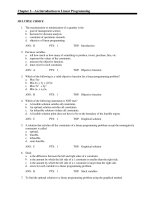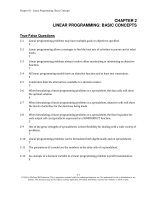Introduction to management science 10e by bernard taylor chapter 08
Bạn đang xem bản rút gọn của tài liệu. Xem và tải ngay bản đầy đủ của tài liệu tại đây (6.22 MB, 82 trang )
Project Management
Chapter 8
Copyright © 2010 Pearson Education, Inc. Publishing as
Prentice Hall
8-1
Chapter Topics
■The Elements of Project Management
■CPM/PERT Networks
■Probabilistic Activity Times
■Microsoft Project
■Project Crashing and Time-Cost Trade-Of
■Formulating the CPM/PERT Network as a
Linear Programming Model
Copyright © 2010 Pearson Education, Inc. Publishing as
Prentice Hall
8-2
Overview
■ Network representation is useful for project
analysis.
■ Networks show how project activities are organized
and are used to determine time duration of
projects.
■ Network techniques used are:
▪ CPM (Critical Path Method)
▪ PERT (Project Evaluation and Review Technique)
■ Developed independently during late 1950’s.
Copyright © 2010 Pearson Education, Inc. Publishing as
Prentice Hall
8-3
Elements of Project
Management
■ Management is generally perceived as concerned
with planning, organizing, and control of an ongoing
process or activity.
■ Project Management is concerned with control of an
activity for a relatively short period of time after
which management efort ends.
■ Primary elements of Project Management to be
discussed:
Project Planning
Project Team
Project Control
Copyright © 2010 Pearson Education, Inc. Publishing as
Prentice Hall
8-4
Elements of Project
Management
Project Planning
■Objectives
■Project Scope
■Contract Requirements
■Schedules
■Resources
■Personnel
■Control
■Risk and Problem Analysis
Copyright © 2010 Pearson Education, Inc. Publishing as
Prentice Hall
8-5
Elements of Project Management
The Project Team
■ Project team typically consists of a group of
individuals from various areas in an organization and
often includes outside consultants.
■ Members of engineering staf often assigned to
project work.
■ Project team may include workers.
■ Most important member of project team is the project
manager.
■ Project manager is often under great pressure
because of uncertainty inherent in project activities
and possibility of failure. Potential rewards, however,
can be substantial.
■ Project manager must be able to coordinate various
Copyright © 2010 Pearson Education, Inc. Publishing as
Prentice Hall
8-6
The Project Management Process
Figure 8.1
Copyright © 2010 Pearson Education, Inc. Publishing as
Prentice Hall
The project
8-7
Elements of Project Management
Scope Statement
■ Document providing common understanding of
project.
■ Justification describing the factors giving rise to
need for project.
■ Expected results and what constitutes success.
■ List of necessary documents and planning reports.
■ Statement of work (SOW) - a planning
document for individuals, team members, groups,
departments, subcontractors and suppliers,
describing what are required for successful
completion on time.
Copyright © 2010 Pearson Education, Inc. Publishing as
Prentice Hall
8-8
Elements of Project Management
Work Breakdown Structure (WBS)
(1■ of
2)breaks down project into major components
WBS
(modules).
■ Modules are further broken down into activities and,
finally, into individual tasks.
■ Identifies activities, tasks, resource requirements and
relationships between modules and activities.
■ Helps avoid duplication of efort.
■ Basis for project development, management , schedule,
resources and modifications.
■ Approaches for WBS development:
Top
down
process
Copyright ©1.
2010
Pearson
Education,
Inc. Publishing as2. Brainstorm entire project
Prentice Hall
8-9
Elements of Project Management
Work Breakdown Structure (2 of
2)
Figure 8.2
WBS for Computer Order-processing System Projec
Copyright © 2010 Pearson Education, Inc. Publishing as
Prentice Hall
8-10
Elements of Project Management
Responsibility Assignment Matrix
(1 of 2)
■ Project manager assigns work elements to
organizational units, departments, groups,
individuals or subcontractors.
■ Uses an organizational breakdown structure (OBS).
■ OBS is a table or a chart showing which
organizational units are responsible for work items.
■ OBS leads to the responsibility assignment matrix
(RAM)
■ RAM shows who is responsible for doing the
necessary work in the project
Copyright © 2010 Pearson Education, Inc. Publishing as
Prentice Hall
8-11
Elements of Project Management
Responsibility Assignment Matrix
(2 of 2)
Figure 8.3
A responsibility assignment
Copyright © 2010 Pearson Education, Inc. Publishing as
Prentice Hall
8-12
Elements of Project
Management
Project Scheduling
■ Project Schedule evolves from planning documents,
with focus on timely completion.
■ Critical element in project management – source of
most conflicts and problems.
■ Schedule development steps:
1. Define activities,
3. Estimate activity times,
2. Sequence activities,
4. Construct schedule.
■ Gantt chart and CPM/PERT techniques can be useful.
■ Computer software packages available, e.g. Microsoft
Project.
Copyright © 2010 Pearson Education, Inc. Publishing as
Prentice Hall
8-13
Elements of Project Management
Gantt Chart (1 of 2)
■ Popular, traditional technique, also known as a bar
chart -developed by Henry Gantt (1914).
■ Direct precursor of CPM/PERT for monitoring work
progress.
■ A visual display of project schedule showing
activity start and finish times and where extra time is
available.
■ Suitable for projects with few activities and
precedence relationships.
■ Drawback: precedence relationships are not always
Copyright © 2010 Pearson Education, Inc. Publishing as
discernible.
Prentice Hall
8-14
Elements of Project Management
Gantt Chart (2 of 2)
Copyright © 2010 Pearson Education, Inc. Publishing as
Prentice Hall
Figure 8.4
A Gantt
8-15
Elements of Project
Management
Project
Control
■
Process of ensuring progress toward successful
completion.
■ Monitoring project to minimize deviations from project
plan and schedule.
■ Corrective actions necessary if deviations occur.
■ Key elements of project control
Time management
Cost management
Performance management
Earned value analysis.
Copyright © 2010 Pearson Education, Inc. Publishing as
Prentice Hall
8-16
The Project Network
CPM/PERT
Activity-on-Arc (AOA) Network
■ A branch reflects an activity of a project.
■ A node represents the beginning and end of
activities, referred to as events.
■ Branches in the network indicate precedence
relationships.
■ When an activity is completed at a node, it has been
realized.
Copyright © 2010 Pearson Education, Inc. Publishing as
Prentice Hall
Figure 8.5
Nodes and
8-17
The Project Network
Concurrent Activities
■ Network aids in planning and scheduling.
■ Time duration of activities shown on branches.
■ Activities can occur at the same time (concurrently).
■ A dummy activity shows a precedence
relationship but reflects no passage of time.
■ Two or more activities cannot share the same start
and end nodes.
Figure 8. 7
Activity
A Dummy
Copyright © 2010 Pearson Education, Inc. Publishing as
Prentice Hall
8-18
The Project Network
House Building Project Data
No. Activity
Duration (Months)
Activity Predecessor
1. Design house and
obtain financing
-
3
2. Lay foundation
1
2
3. Order Materials
1
1
4. Build house
2, 3
3
5. Select paint
2, 3
1
6. Select carpet
7. Finish work
Copyright © 2010 Pearson Education, Inc. Publishing as
Prentice Hall
5
1
4, 6
1
8-19
The Project Network
AOA Network for House Building
Project
Figure 8.6
Expanded Network for
Building a
Copyright © 2010 Pearson Education, Inc. Publishing as
House
Prentice
Hall Showing Concurrent
8-20
The Project Network
AON Network for House Building Project
Activity-on-Node (AON) Network
A node represents an activity, with its label and time shown on the no
The branches show the precedence relationships
Convention used in Microsoft Project software
Figure 8.8
Copyright © 2010 Pearson Education, Inc. Publishing as
Prentice Hall
8-21
The Project Network
Paths Through a Network
Path
A
B
C
D
Events
1247
12567
1347
13567
Table 8.1
Paths Through the House-Building
Copyright © 2010 Pearson Education, Inc. Publishing as
Network
Prentice Hall
8-22
The Project Network
The Critical Path
The critical path is the longest path through the
network; the minimum time the network can be
completed. From Figure 8.8:
Path A: 1 → 2 → 4 → 7
3+2+3+1=9
months
Path B: 1 → 2 → 5 → 6 → 7
3+2+1+1+
1= 8 months
Path C: 1 → 3 → 4 → 7
3+1+3+1=8
months
Copyright © 2010 Pearson Education, Inc. Publishing as
Prentice Hall
8-23
The Project Network
Activity Start Times
Copyright © 2010 Pearson Education, Inc. Publishing as
Prentice Hall
Figure 8.9 Activity
start time
8-24
The Project Network
Activity-on-Node Configuration
Figure 8.10 Activity-on-Node
Copyright © 2010 Pearson Education, Inc. Publishing
Configuration
as Prentice Hall
8-25









